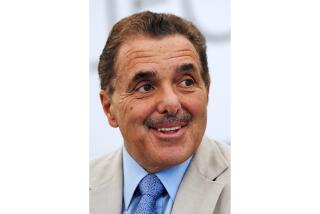Glitter, Glitter : Go Forth And Spend : LAND OF DESIRE: Merchants, Power, and the Rise of a New American Culture, <i> By William Leach (Pantheon: $30; 510 pp.)</i>
‘The man who does not advertise is a dead one,’ says early PR wizard Elbert Hubbard in this history of consumerism.
Before wistfully recalling a simpler, austere America, read “Land of Desire.” Consumerism, William Leach shows in depth, is no overnight phenomena. We just can’t blame it on MTV, Ronald Reagan or other contemporary hucksters.
It all started late in the 19th Century, a time when the seeds of consumerism were planted--and richly harvested--by such merchant princes as John Wannamaker, the Straus brothers, Marshall Field and A. T. Stewart. With the nation shifting from a producer-based agrarian society to a consumer-oriented industrial economy, these merchants built the first major department stores, creating a new gap between producer and consumer. That gap was filled by the merchants’ ability to tap into a key emotion that in fact had always been at the core of the American Dream: desire.
Long before Procter & Gamble, Nike or Coke ever shot their first commercials, these merchants understood the power of compelling visual images. In those Gilded Age years, glass was a major medium, “a symbol of the merchant’s unilateral power in a capitalist society to refuse goods to anyone in need, to close off access without being condemned as cruel and immoral. . . . At the same time, the pictures behind the glass enticed the viewer.”
Leach’s skill at dissecting the multi-stranded shades of history as paradox and ambiguity also shows up in his analysis of the mystical connection many business leaders made between religion and capitalism. This resulted in a puzzling synthesis, wherein the concept of “service” evolved from contributing to those less fortunate to providing shoppers with refund policies, home delivery and more. Making money, marketing goods and “servicing” consumer “needs” (which when closely examined are closer to “wants”) took on all the aspects of a Holy Crusade.
Detailing the historical forces and actions that vividly and lucratively brought the Protestant Ethic to life, he shows how John Wannamaker, owner of an enormous Philadelphia department store, donated millions of dollars and thousands of hours to his church--a commitment to “service” that Wannamaker saw as directly tied to the needs of his store. “Service emerged,” writes Leach, “because merchants had to move goods.”
Yet it also reigned as an ideal: “At a time of economic inequity and labor conflict, many Americans linked service with the ‘promise of America.’ ”
Alongside this form of “upbeat and liberal” Protestantism there grew new theories of economics and sociology, strongly built on the idea “that the United States was destined to escape what had historically been humanity’s inevitable burden: scarcity.” Even more profoundly, there grew a belief that producing vast quantities of goods, selling them and of course, relentlessly buying them, performed a function that was not only good for the economy, but morally positive and “led inexorably to peace, human betterment, stability, ‘gentleness’ and civility.”
In addition to merchants, Leach describes the emerging “broker class”--that is, those agents of capitalism who produced little in their own right save for the ability to create the opportunities (through finance, media and other cultural forces) that would accelerate the wheels of commerce.
Lest you think bankers only recently began mucking up the economy, Leach provides extensive details on the role of such now-familiar firms as Lehman Brothers and Goldman, Sachs in supporting the growing economy of the early 20th Century. The script sounds familiar, as Leach explores “merger mania,” consolidation, and other Wall Street activities: “Bankers assisted in undermining the competitive ethos by directing business interest toward concentration and easy economic fixes.”
The then-nascent power of advertising and public relations is analyzed through looks at such masters as Elbert Hubbard and Edward Bernays. “The man who does not advertise is a dead one, whether he knows it or not,” Leach quotes Hubbard as saying. “Life is too short for you to hide yourself away mantled in your own modesty.”
Alongside all this there also grew an attendant popular culture. Heavily refuting the notion that Frank L. Baum’s “The Wonderful Wizard of Oz” is a populist critique of capitalism, Leach demonstrates how Baum’s earlier career as a creator of window displays helped spur him to create “An Affirmative American Fairy Tale.” The famed Yellow Brick Road is “tied with a world overflowing with commodities, particularly food, jewels, metals.” Dorothy’s odyssey, Leach asserts, is right in line with the growing brand of “Mind-Cure” culture, an ever-growing belief that Americans can have it all without any psychic or economic pain.
It doesn’t take too much of a critical compass to see that Leach’s study of a prior epoch has direct implications for understanding our own time, a period where we are still grappling with the social and fiscal impact of 12 years of “Mind-Cure” leadership. Next time you enter the territory of nostalgia, read Leach’s book and learn that the past is more than a carefully housed set of events and memories. The past is in front of us.
More to Read
The biggest entertainment stories
Get our big stories about Hollywood, film, television, music, arts, culture and more right in your inbox as soon as they publish.
You may occasionally receive promotional content from the Los Angeles Times.










